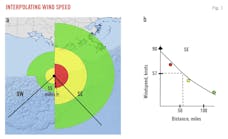IPAA: Independent review finds EPA Pavillion report lacks data
An independent review of the US Environmental Protection Agency’s draft report on water near Pavillion, Wyo., concluded scientific analysis fails to support EPA’s suggestion that hydraulic fracturing possibly contributed to water contamination, the Independent Petroleum Association of America reported.
Groundwater and hydrogeology consultant S.S. Papadopulos & Associates Inc. (SSPA), Bethesda, Md., concluded in its independent review that EPA used unapproved analytical methods and improperly conducted various field procedures and misinterpreted data.
“Through this review, the science speaks for itself,” Lee Fuller, IPAA vice-president of government relations, said in a May 15 news release. “Unfortunately, the EPA has continued to miss the mark with its draft report. We encourage EPA to work with the state of Wyoming and the US Geological Survey, among other stakeholders, to reexamine the two EPA monitoring wells.”
IPAA hopes EPA will work toward “better methodology and reporting in the future,” Fuller said. SSPA prepared the report for the IPAA.
EPA said its investigation of groundwater in Pavillion found chemicals consistent with natural gas production and frac fluids. EPA collected samples from various water wells during March 2009-April 2011 while it studied water-quality concerns in the community 20 miles northwest of Riverton.
Encana Oil & Gas (USA) Inc. has questioned the source of some chemicals found in EPA water well samples (OGJ Online, Jan. 2, 2012).
The water wells are near Pavillion gas field, which has 169 vertical production wells. EPA launched an investigation, collecting samples from various water wells in a four-phase program during March 2009-April 2011.
SSPA identified the following specific deficiencies related to EPA’s study:
• Poor study design, including lack of appropriate conceptual model and failure to evaluate alternative conclusions.
• Lack of baseline and background data, specifically related to methane and other natural occurring organic and inorganic compounds, and failure to include and account for USGS data showing historically poor regional groundwater quality.
• Analytical concerns leading to incorrect conclusions, including detections of compounds of concern in quality assurance-quality control blank samples, poor correspondence between analytical standards and test samples, and utilization of unapproved methods and procedures.
• Serious errors in the construction, development, and sampling of two new monitoring wells that EPA drilled into known gas formations (deeper than any nearby domestic wells) and used this well data to support numerous, key conclusions. In addition, multiple concerns regarding the appropriate construction and development of these wells could explain results EPA interpreted as contamination from fracing.
• Lack of suitable samples because two samples from each of the two new monitoring wells were used to support the bulk of the EPA’s conclusions.
• No source identification because EPA never addressed the original complaints from the residents as to the source of the bad-tasting, foul-smelling drinking water produced from the residential water wells.
Contact Paula Dittrick at [email protected].

Paula Dittrick | Senior Staff Writer
Paula Dittrick has covered oil and gas from Houston for more than 20 years. Starting in May 2007, she developed a health, safety, and environment beat for Oil & Gas Journal. Dittrick is familiar with the industry’s financial aspects. She also monitors issues associated with carbon sequestration and renewable energy.
Dittrick joined OGJ in February 2001. Previously, she worked for Dow Jones and United Press International. She began writing about oil and gas as UPI’s West Texas bureau chief during the 1980s. She earned a Bachelor’s of Science degree in journalism from the University of Nebraska in 1974.
